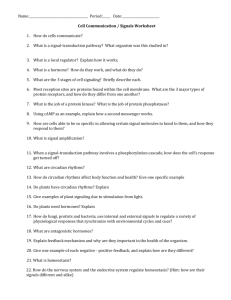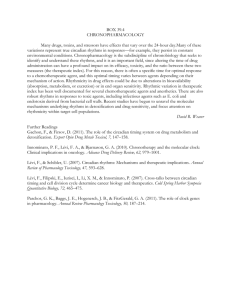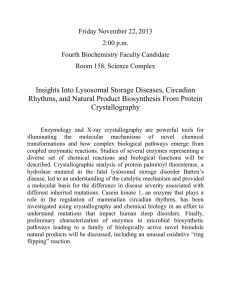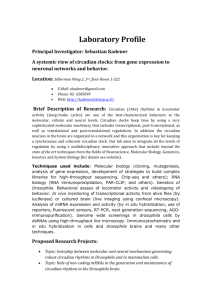Biological Rhythms - Cornell University Ergonomics Web
advertisement
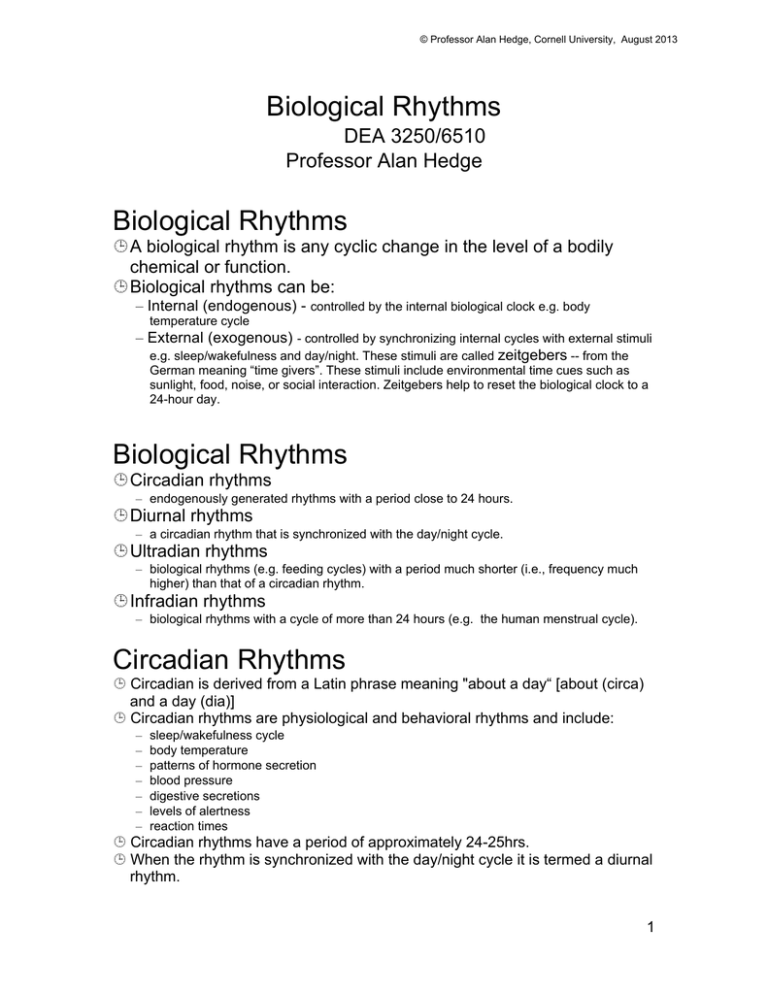
© Professor Alan Hedge, Cornell University, August 2013 Biological Rhythms DEA 3250/6510 Professor Alan Hedge Biological Rhythms ¹ A biological rhythm is any cyclic change in the level of a bodily chemical or function. ¹ Biological rhythms can be: – Internal (endogenous) - controlled by the internal biological clock e.g. body temperature cycle – External (exogenous) - controlled by synchronizing internal cycles with external stimuli e.g. sleep/wakefulness and day/night. These stimuli are called zeitgebers -- from the German meaning “time givers”. These stimuli include environmental time cues such as sunlight, food, noise, or social interaction. Zeitgebers help to reset the biological clock to a 24-hour day. Biological Rhythms ¹ Circadian rhythms – endogenously generated rhythms with a period close to 24 hours. ¹ Diurnal rhythms – a circadian rhythm that is synchronized with the day/night cycle. ¹ Ultradian rhythms – biological rhythms (e.g. feeding cycles) with a period much shorter (i.e., frequency much higher) than that of a circadian rhythm. ¹ Infradian rhythms – biological rhythms with a cycle of more than 24 hours (e.g. the human menstrual cycle). Circadian Rhythms ¹ Circadian is derived from a Latin phrase meaning "about a day“ [about (circa) and a day (dia)] ¹ Circadian rhythms are physiological and behavioral rhythms and include: – – – – – – – sleep/wakefulness cycle body temperature patterns of hormone secretion blood pressure digestive secretions levels of alertness reaction times ¹ Circadian rhythms have a period of approximately 24-25hrs. ¹ When the rhythm is synchronized with the day/night cycle it is termed a diurnal rhythm. 1 © Professor Alan Hedge, Cornell University, August 2013 Circadian Clock ¹ In humans (and other mammals), a circadian clock is located in the suprachiasmatic nuclei (SCN). ¹ The SCN is in the hypothalamus. It is a tiny cluster of about 10 thousand nerve cells. ¹ This circadian clock is synchronized to the external cycles of light and darkness and social contact. The synchronized rhythm is called the diurnal rhythm. ¹ Disruption of the clock or its synchronization occurs during jet-lag, shift work and old-age. ¹ Disruption of the clock detrimentally affects our well-being and mental and physical performance. Biological Clock and Melatonin ¹ The circadian clock controls longer term cycles: – seasonal rhythms in reproduction – seasonal rhythms metabolism and appetite ¹ The pineal hormone melatonin, (a hormone that induces sleep) mediates this seasonality. ¹ The SCN clock ensures that melatonin is secreted only at night. Melatonin secretion last longer on the longer winter nights. ¹ The duration of the circadian melatonin is used by the brain to orchestrate seasonal rhythms. Biorhythm Terminology Body Temperature and Sleep Cycle Drowsiness increases as body core temperature falls, and also as this rises beyond the normal range (e.g. fever) Body Temperature Cycle Hormonal Cycles Menstrual Cycle Effects (Hartley et al. 1987 Ergonomics 30, 111-120) ¹ 30 women with regular menstrual cycles tested on immediate and delayed verbal retention, immediate memory for acoustically and semantically confusing word lists, and verbal reasoning. Menstrual Distress Questionnaire (MDQ) administered. ¹ Testing carried out at three phases of the menstrual cycle: ovulation, menstruation and the premenstrual phase. ¹ Immediate and delayed recall showed no differences across the three phases. ¹ Speed of verbal reasoning was found to be slower on more complex sentences during ovulation. ¹ Recall of semantically similar lists was impaired in ovulation. ¹ Recall of acoustically similar lists tended to be impaired in the premenstrual phase. ¹ MDQ self-reported arousal was higher in ovulation. ¹ Distress was higher in the premenstrual phase. 2 © Professor Alan Hedge, Cornell University, August 2013 Morning-Evening Types ¹ Morningness and Eveningness describe a person’s individual circadian profile. – Morning people usually prefer to rise between 5 a.m. and 7 a.m., and retire between 9 p.m. and 11 p.m. – Evening people tend to prefer both a later wake up (9 a.m. to 11 a.m.) and a later bed time (11 p.m. to 3 a.m.). ¹ Morning people also tend to be more rigid in their circadian rhythms. ¹ Evening people find adjustment to new schedules somewhat easier. ¹ Most people fall somewhere between these two types. Morning/Evening Types and Body Temperature Post-lunch Dip Effect ¹ The "post-lunch dip" is a period of decreased alertness that strikes between 1 p.m. and 4 p.m. ¹ Between 1 p.m. and 4 p.m.: – work performance suffers – people in dimly lit meeting rooms are apt to nod off – the likelihood of getting into a car accident increases. ¹ Daily body temperature, hormone levels and other physiological cycles place us at a low ebb in the early afternoon, in contrast to periods of peak alertness we experience in the morning and early evening. ¹ The post-lunch dip occurs whether you eat lunch or not, but, a large, heavy lunch can exacerbate the effect. ¹ Strategies for coping with the post-lunch dip: – – – – a brief power nap (no longer than 10-15 minutes) a brisk walk outside drinking tea, coffee or ice-cold juice doing work that requires moderate physical exertion. ¹ If possible, the most mentally demanding work should be done in the morning or evening, depending on a person’s rhythm. Time-of-day and Errors ¹ Human error catastrophes, such as Three Mile Island, Bhopal and Chernobyl, occurred in the middle of the night. ¹ The majority of single-vehicle driving accidents occur in the hours near dawn. ¹ We have relatively poor senses of night vision, hearing and smell compared with predatory animals, consequently our circadian rhythms put us to sleep at night for protection, and wake us up and get us going again the next day. ¹ The biological imperative to sleep creates problems for shift work, and for the military. ¹ Time-of-day (TOD) effects are highly variable between people. TOD and Visual Search ¹ Several studies show that visual search speed performance is better in the morning than the evening (Monk, 1979). 3 © Professor Alan Hedge, Cornell University, August 2013 TOD and Thinking ¹ Performance on thinking tests is better around lunchtime than in the morning or evening (Folkard, 1975). TOD and Immediate Memory ¹ TOD effects on immediate memory for prose (Folkard and Monk, 1980). TOD and Working Memory ¹ TOD effects on working memory depend on the memory load of the task (Folkard and Monk, 1979). Body Temperature and Alertness ¹ Ratings of alertness closely track body temperature (Monk and Embrey, 1981). Shift Work ¹ 20% US workforce (22 million workers) work outside of normal Mon.-Fri. 95pm workday (Shiftwork Practices, 1999). ¹ “Industrial jet lag" -- fatigue that results when the body hasn’t adjusted its circadian rhythms to temporal shift changes. ¹ After three or four night shifts, the body still won’t be 100% adjusted to night work, but circadian rhythms will have shifted enough to make it easier to stay alert throughout the night. ¹ Circadian rhythms can only shift an hour or two per day when a person changes his or her sleep schedule, so resynchronization (entrainment) takes several days. Entrainment ¹ 17 male workers on 3 shifts: – C starts at midnight – A at 8 am – B at 4pm. ¹ Entrainment shifts the oral temperature rhythm and reduces its amplitude. 4 © Professor Alan Hedge, Cornell University, August 2013 Time-Zones and Jet lag ¹ Circadian rhythms are disrupted when we travel across time zones or work at night. ¹ Jet lag recovery time can be calculated as follows: Rest period = (0.5 x travel time) + # time zones + departure + arrival (1/10’s of days) (hrs.) (>4) coefficient coefficient (local time) (local time) ¹ Generally, travel from West to East produces more jet lag before of the loss of night time. Departure and Arrival Time Coefficients Jet Lag calculations ¹ Fly from Paris to NYC (flight time=9 hrs, 5 time zones) Assume leaving Paris at 2 pm, arriving NYC at 6 pm. RP = 0.5 x 9 +1 +1 + 0 = 6.5 tenths = 0.65 day (~0.5 day) Assume leaving Paris at 7 pm, arriving NYC at 11 pm. RP = 0.5 x 9 +1 +3 + 1 = 9.5 tenths = 0.95 days (~1 day) ¹ SST doesn’t necessarily reduce jet lag depending on the time of travel. Assume leaving NYC at 10 pm, arriving Paris at 1 pm.(10 hrs. flight) RP = 0.5 x 10 +1 +4 + 2 = 12 tenths = 1.2 days (~1 day) Assume leaving NYC at 10 pm, arriving Paris at 8 am (5 hrs. flight on Concord) RP = 0.5 x 5 +1 +4 + 4 = 11.5 tenths = 1.15 days (~1 day) Biorhythms Theory ¹ A pseudoscientific theory claiming that our daily lives are significantly affected by 3 rhythmic cycles: – Physical – 23 days cycle – Emotional – 28 days cycle – Intellectual – 33 days cycle ¹ Examination of some 134 biorhythm studies found that these frequently had methodological and statistical errors, and there is no scientific evidence to support the theory (Hines, 1998). 5 © Professor Alan Hedge, Cornell University, August 2013 Additional Resources Internet resources on Chronobiology (http://www.epub.org.br/cm/n04/mente/recritmos_i.htm) Good resource center for Chronobiology (http://www.circadian.com/) For a critical overview of biorhythms see (http://skepdic.com/biorhyth.html) Biological rhythms software (just for fun) (http://www.circadian.org/softwar.html) 6
